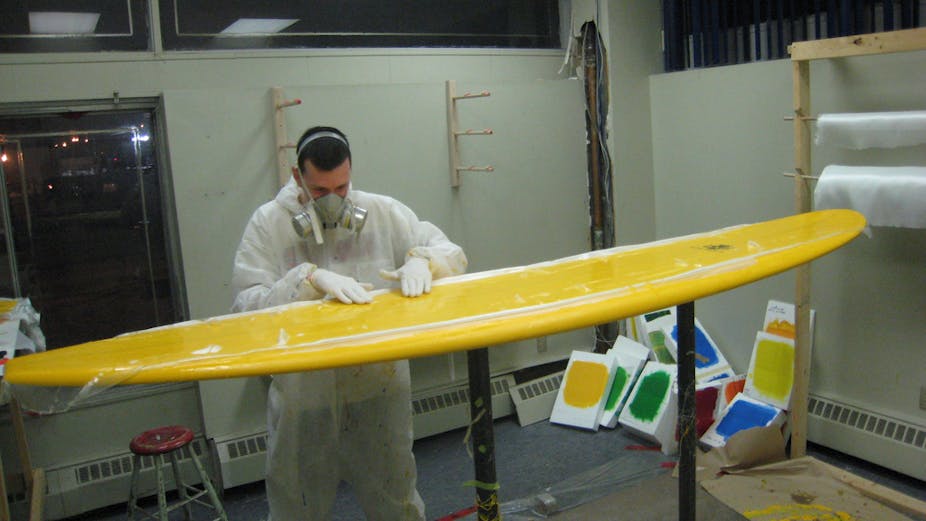Ford’s announcement that it will cease making cars in Australia is an enormous blow to manufacturing, and especially to the workers involved. But does it mean Australian manufacturing on its deathbed? Far from it.
Manufacturing: it’s not just economics
The public debate overlooks the diversity of Australian manufacturing. What happens to the automotive industry is not necessarily indicative of other sectors.
The assumption that manufacturing is dying overlooks innovation, diversity, specialisation, and human skills. It also ignores the fact that Australian manufacturing output has quadrupled since the 1950s.
The truth is that the face of Australian manufacturing is changing. Overall employment numbers are in steady decline, but the proportion of high-skill workers is actually increasing and many sectors are expanding. Manufacturing competitiveness is not just a high dollar problem. We need to look inside industries and regions to identify opportunities. New research that cuts across technology, economics and the social sciences will be crucial.
Indeed, there are opportunities to grow Australian manufacturing in new and diverse ways. But we will need to move beyond glib headlines about the death of manufacturing, and appreciate that manufacturing is no longer simply about production lines, low-cost labour and cheap, throwaway products.
The question is not whether Australia should have a car industry or a manufacturing sector, but what kinds of high quality, lasting things Australia should make, and where are the opportunities. After all, a deep part of regional and even national pride comes from the things we make.
Opportunities abound but the race is on
There are huge opportunities at the high-tech end of the spectrum. Australian manufacturers are mostly small companies working within specific niches. And yet they are world leaders in a wide range of products, from compost bins to the cochlear implant, musical instruments to polymer bank notes and from 4-wheel drive accessories to wi-fi. Manufacturing is also about specialist services, product design, prototyping and testing – not just assembly lines.
The research sector is vital to future innovation. There is no shortage of great ideas emerging from university and government research labs across Australia.
The University of Wollongong’s own research efforts span high strength alloys, better battery materials, bionic implants and nanomaterials. Researchers are also developing innovative machinery like high productivity welding systems, 3D-printers, metal forming systems and autonomous robots. These are just a snapshot of the strength of Australia’s manufacturing-related research. Those countries that are able to best harness their research capacity and convert ideas into industries will gain the advantage. It’s another reason the federal government should continue to grow the higher education sector, rather than cut its funding.
Innovation by design
Manufacturing innovation is not just about technical advances. Other kinds of manufacturing will rely on making the most of human skills. The key will be to harness existing abilities to craft things by hand, integrating high quality and design, and to better promote and value the human input into how things are made.
The surfboard industry is a great example. The traditional method relies on hand-shaping boards, customised to individual surfers and local waves. It happens in small workshops who maintain strong connections with local surfing communities. That strong local connection and customisation means that designs can evolve constantly as surfers and boardmakers experiment with more radical designs to get a thrilling wave ride. Upon this basis, Australia has become the world leader in new surfboard design.
However, cheap imported boards, made using computer design and cutting technology, are undercutting the lower end of the market, where retail competition is most fierce. When Australian surfboard makers have sought to compete on price, they have failed. Where they survive is based on quality, innovation, hand-crafting, and a personal connection with the customer. So the strategy will need to be very different for this industry than for cars or health products.
Transforming lives and regions
The debate must also appreciate the regional basis of manufacturing. The downstream effects of Ford’s closure will be region-specific and intense. Attempts to alleviate regional impacts of manufacturing contraction – such as in the Illawarra after 2011 cutbacks at BlueScope Steel – have had very limited success. Governments have thrown money at the problem too quickly, without a good evidence base for what might work. Retraining and job placement schemes have operated without broader strategic regional development, infrastructure and industry support. No amount of retraining or job subsidy will work if the jobs, infrastructure and planning aren’t there.
This is why we need qualitative social science research — as well as high-tech science — on the aspirations and capacities of manufacturing workers within regions. Social scientists can help us explain what those workers ultimately aspire to be. Surely, in light of Ford’s announcement this week, that is among the highest priorities of all.

